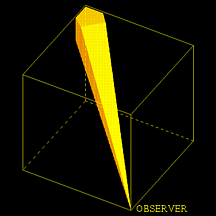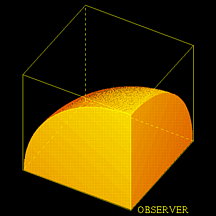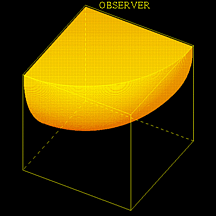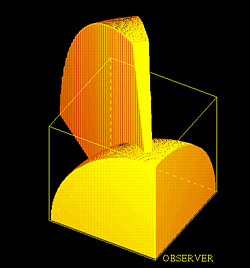 DW has origin (0,0,0) and is directed toward (1,1,1)
DW has origin (0,0,0) and is directed toward (1,1,1)
|
Virgo Consortium Hubble Volume Simulations Cluster Catalogs from Light Cone Datasets |
| Light-cone Surveys |
Five separate light-cone 'sky' surveys are produced by each run. Their
properties are summarized in the following table -
| Survey type | Angular coverage | R_max(Mpc/h) | z_max |
| octants | pi/2ster | 3000 | 1.46 |
| oct+wedge(*) | pi/2 ster | 6000 | 6.8 |
| spheres | 4pi ster | 1500 | 0.58 |
| deep wedge | 100 sqdeg | 5100 | 4.37 |
| Survey type | Angular coverage | R_max(Mpc/h) | z_max |
| octants | pi/2ster | 2000 | 1.25 |
| spheres | 4pi ster | 1000 | 0.44 |
| deep wedge | 100 sqdeg | 3400 | 4.60 |
The surveys are centered at the following locations in the original simulation cube (mapped to 0-1 interval) -
 DW has origin (0,0,0) and is directed toward (1,1,1)
DW has origin (0,0,0) and is directed toward (1,1,1)
 PO has origin (0,0,0) and is directed toward (1,1,1)
PO has origin (0,0,0) and is directed toward (1,1,1)
VS has origin (0,0,0) and uses octants from that location plus the
7 other vertices (periodic replications of the origin)
 NO has origin (1,1,1) and is directed toward (0,0,0)
NO has origin (1,1,1) and is directed toward (0,0,0) POW has origin (0,0,0) and is directed toward (1,1,1)
POW has origin (0,0,0) and is directed toward (1,1,1)
| Cluster Catalog Files |
Cluster catalogs derived from a SPHERICAL OVERDENSITY method applied to the light-cone particle data. Cluster lists are found in files of the form
grpSO.d$delta_c/$model.$survey.msort$min
where
$delta_c = { 200, 500 } is the defining density threshold
$model = { tcdm, lcdm } is the cosmological model
$survey = { DW, VS, MS, NO, PO/POW } is the choice of sky survey
$min = { 12, 48 } is the minimum particle count of the cluster
# m zred sigma ip x y z vx vy vz
where
In the cluster data sets, survey coordinate systems are defined so that the survey origins are located atm = number of particles (particle mass is 2.22/2.25e12/h for tcdm/lcdm) zred = redshift sigma = measured 1D velocity dispersion ip = parent flag (see below) x,y,z = cluster location in SURVEY COORDINATES in 0-1 units vx,vy,vz= physical peculiar velocity in km/s
| Cluster Finding Algorithm |
Clusters are identified using a spherical overdensity method with the
following steps:
+ IPARENT flag
The issue of ovelapping clusters is handled as follows. A cluster
is defined to be a parent if it is the largest of any group of
clusters with which it overlaps. Isolated clusters are parents by
default. The `family' criterion employed is that the threshold spheres
of pair i & j overlap:
| cen_i - cen_j | <= Rvir_i + Rvir_j
Note that the center of any cluster cannot lie within the threshold radius of any cluster other than itself.
| Additonal Cluster Data |
The catalog files are shortened versions of the original group finder output. The group finder processes planes of cubes in the Z-direction. Separate output files for each Z-slice are produced. These files can be made available upon request.
For each slice iz, there are three output files:
# M {X Y Z}_c {Vx Vy Vz V}_com sigma1D R R.5 S.5 {X Y Z}_mb {X Y Z}_com
where
M = cluster mass in particles (1 particle = 2.2e12/h Msol in both models)
{X Y Z}_c = cluster center (1)
{Vx Vy Vz V}_com = center-of-mass velocity components and speed (2)
sigma1D = one-dimensional velocity dispersion (2)
R = cluster radius (1)
R.5 = ratio of half mass radius to full radius R_{1/2}/R
S.5 = ratio of velocity dispersions within R_{1/2} and R
{X Y Z}_mb = position of most bound cluster member (1,3)
{X Y Z}_com = position of cluster center-of-masss (1)
Notes:
# {Rxx Rxy Rxz Ryy Ryz Rzz} {Vxx Vxy Vxz Vyy Vyz Vzz}
where
Rij = Sum_k (R-R_c)_i (R-R_c)_j / M Vij = Sum_k (V-V_com)_i (V-V_com)_j / M and the sum is over members k running from 1 to M.The *.iparent files contain the integer iparent flag for each cluster.
Original text file written by August.E.Evrard.
Last modified: Wed July 24 13:42:54 MDT 2000 by Virgo Administrator